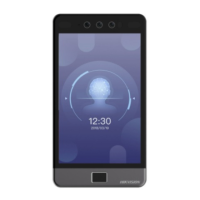
Do you have a question about the HIKVISION DS-K1T981 Series and is the answer not in the manual?
| Brand | HIKVISION |
|---|---|
| Model | DS-K1T981 Series |
| Category | Touch terminals |
| Language | English |
Provides overview and usage instructions for the manual, including product description and support.
Lists Hikvision's trademarks and other mentioned trademarks, noting their ownership.
Outlines terms of use, liability limitations, user responsibilities regarding product use and security.
Details FCC compliance, testing limits, and guidelines for preventing radio frequency interference.
Confirms product compliance with applicable harmonized European standards like EMC and RE directives.
Highlights critical warnings that, if neglected, may cause serious injury or death.
Outlines precautions to prevent potential injury or material damage from improper use.
Introduces the access control terminal, its purpose, and typical applications.
Lists the key features and technical specifications of the access control terminal.
Details specific features and capabilities of the standard series model.
Specifies requirements for the device's installation location, lighting, and distance from environmental factors.
Provides step-by-step instructions for mounting the device using a standard gang box.
Details the procedure for mounting the device directly onto a surface using a template.
Explains how to mount the device using a bracket, including turnstile installations.
Explains the function and purpose of each terminal connector on the device.
Illustrates how to connect the terminal with standard peripherals and wiring diagrams.
Shows the wiring diagram for connecting the device to a secure door control unit.
Describes wiring diagrams for integrating the device with fire alarm systems.
Guides on activating the device directly through its on-screen interface.
Explains the process of activating the device by accessing its web interface.
Details how to activate and manage devices using the SADP tool over the LAN.
Covers device activation using the iVMS-4200 client software.
Instructs on selecting the appropriate application mode (Indoor/Others) for the device.
Guides on configuring wired and Wi-Fi network settings for the device.
Explains how to enable and configure access to the Hik-Connect platform.
Details how to configure privacy parameters like picture uploading and storage.
Covers adding and configuring an administrator account for device management.
Describes the process of logging into the device interface.
Explains the specific procedures for logging in as an administrator.
Details how to log in using the device's activation password.
Covers configuring network, Wi-Fi, RS-485, Wiegand, and ISUP settings.
Guides on configuring IP address, subnet mask, gateway, and DNS for wired connections.
Details how to connect and configure Wi-Fi settings for wireless network access.
Details how to configure RS-485 communication parameters for peripherals.
Explains how to configure Wiegand transmission direction and mode.
Describes how to set ISUP parameters for device data upload via ISUP protocol.
Covers setting server address and verification code for Hik-Connect mobile client.
Explains how to add, edit, delete, and search user information.
Details the process of adding an administrator account for device management.
Guides on adding face pictures for user authentication.
Details how to add fingerprints for user authentication.
Explains how to add cards for user authentication.
Guides on adding iris information for user authentication.
Describes how to view the PIN code for user authentication.
Covers setting the authentication modes for users (Device or Custom).
Explains how to search for users and edit their information.
Covers deleting, importing, and exporting device data via USB.
Explains how to authenticate users via single or multiple credentials.
Details authentication using a single credential like face, card, or QR code.
Covers multi-credential authentication methods.
Allows configuration of shortcut keys, voice prompts, time, and community details.
Guides on customizing face recognition parameters for optimal performance.
Covers settings for authentication mode, NFC, door contact, and intervals.
Details how to configure attendance modes like manual, auto, and disable.
Covers rebooting, restoring factory/default settings, and upgrading device firmware.
Explains functions related to video intercom calls between devices and clients.
Describes how to log in to the device using a web browser.
Guides on viewing live video, capturing images, and recording.
Covers adding, editing, and managing person information via the web interface.
Explains how to search for events based on various criteria.
Details various device configuration options accessible via the web interface.
Covers settings for live view, record files, and saving paths.
Shows how to view detailed device information like model, serial number, and capacity.
Guides on setting time zone, synchronization mode, and device time.
Details how to configure Daylight Saving Time settings.
Information on viewing open source software licenses associated with the device.
Covers rebooting, restoring settings, and upgrading device firmware.
Explains how to search and view device logs with filtering options.
Covers setting security modes (High/Compatible) for client login.
Details managing server/client certificates and CA certificates.
Guides on changing the administrator password for enhanced security.
How to view device arming type and associated IP address.
Covers TCP/IP, port, Wi-Fi, and report strategy settings.
Details configuration of image quality, resolution, and audio volume.
How to customize audio prompts for successful/failed authentication.
Guides on setting video standard, WDR, brightness, contrast, and saturation.
Details how to adjust the brightness of the supplement light.
Covers disabling attendance mode and setting time/attendance parameters via web.
Covers authentication parameters and card reader settings.
Details setting video intercom parameters and device types.
Presents a flow diagram illustrating the client software configuration steps.
Guides on managing access control and video intercom devices within the client.
Details methods for adding devices to the client software by IP, segment, or ISUP.
Explains how to reset device passwords via the client software.
Covers editing device parameters, remote configuration, and status viewing.
Details how to group devices and manage resources by location.
Guides on creating groups for organizing and managing devices.
Explains importing device resources like access points into groups.
Covers adding, importing, and exporting person information and credentials.
Details how to add and manage organizational structures for persons.
Explains importing and exporting person data and pictures in batches.
How to retrieve person data from the device and import it to the client.
Guides on issuing cards to multiple persons simultaneously.
Details how to report a lost card and disable its access authorization.
Covers settings for reading card numbers via enrollment station or card reader.
Allows configuration of week schedules and holidays for access authorization templates.
Guides on creating and configuring holiday periods for access control.
Details creating templates with schedules and holidays for access authorization.
Covers creating access groups and assigning authorizations to persons for doors.
Allows configuring advanced access control features like multi-factor authentication.
Details configuring parameters for access control devices, points, inputs, outputs, etc.
Covers additional parameters for face recognition, RS-485, and Wiegand.
Covers monitoring and controlling door/elevator status remotely.
Guides on controlling door states like unlock, lock, and remain open/closed.
Explains how to view real-time access logs, including captured pictures and temperature.











